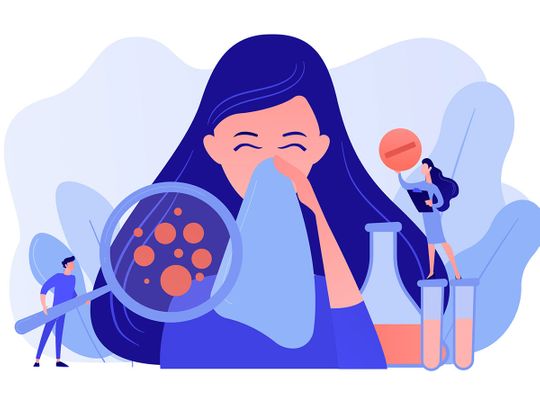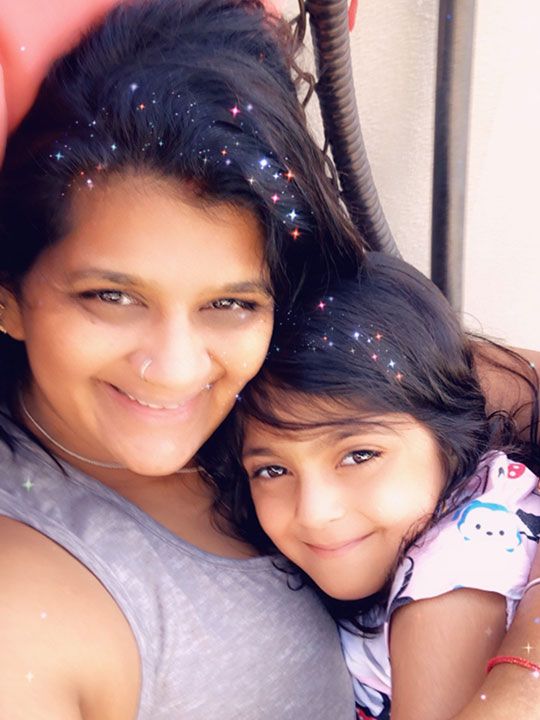
“She was anaphylactic once and that was enough for her to realise that there are consequences to her actions. It’s a really hard way for a three-and-a-half-year-old to learn,” says Sonali Goenka, mum of two, recalling her daughter Anaya Varma’s reaction to something she’d eaten on the sly.
Anaya had always had sensitive skin, but the steroid creams that the doctors slathered her in seemed to be working. But it seemed like each time they went back to the doctor, there was a little more medication required to dull the itch. “It wasn’t sitting well with me or my husband. At some point when she was three-and-a-half we took her to a homeopath who told us to stop all medications, which we did… her skin went absolutely bonkers.
“She had 97 per cent eczema coverage of which 48-50 per cent were weeping sores,” says the 42-year-old Dubai-based Indian expat.
Devastated, the parents went back to the topical medicine, but this time things had gotten worse. “I’d finish a tube of steroid in 10 days and it was the only way to control the itching for long enough for her skin to stitch itself together enough so it wasn’t bleeding anymore. We went to dermatologist after dermatologist and somehow, all of them kept giving us a higher intensity steroids. And it got to a point where all of them said, ‘you know what, she’s going to have to take oral steroids’. And I was like, that’s not happening,” says the co-founder of the ‘Thriving with allergies’ programme.
Then, they got intolerances and allergy panel test done. “It turned out that she was intolerant of 48 foods and allergic to seven, which included pretty much 100 per cent of her diet.”
The foods she was intolerant to included:
- all forms of gluten,
- all forms of milk,
- all nuts,
- tomatoes,
- potatoes,
- lentils, and
- pulses.
The American Academy of Allergy, Asthma & Immunology explains: “A food intolerance response takes place in the digestive system. It occurs when you are unable to properly breakdown the food. This could be due to enzyme deficiencies, sensitivity to food additives or reactions to naturally occurring chemicals in foods. Often, people can eat small amounts of the food without causing problems. A food allergic reaction involves the immune system. Your immune system controls how your body defends itself.”
Knowing what was causing all the trouble was insightful for the couple but also dumfounding. “I remember when we first got her report, we went to the organic store, spent about three hours there and walked out with one packet of chips that she could eat.

“She was vegetarian at the time and intolerant of lentils and all pulses, so at one point my husband and I were looking at her and saying, ‘what do I give her?’”
“For a month, she had boiled rice and water, because we couldn’t figure out what to feed her. We stopped the steroids – it took us a while to adjust,” says Goenka.
She tried the experts, but it only frustrated her further. “I met a nutritionist, a dietician and two allergy specialists in the country, a paediatrician in the UK and a licensed nutritionist in the US. I got food charts – completely useless. I remember the first time I tried to make chapati [flat bread] with gluten-free flour; it was such a disaster. She just refused to eat it – she took one look at it and said yuck.
”I was constantly given charts telling me what she could not do – but I was like, I know what she can’t do, now what do I do? You have to make her eat chicken – but if she’s not eating chicken, what do I do?
“It took a huge mindset shift for everyone in the house including the nanny, because it takes a while when you get an allergy report with huge red marks to stop looking at the red and start looking at the green. We did get their eventually but it was a huge process for us – it was process of trial and error.”
“We started turning things around, started getting her to accepting foods that she would refuse earlier because there were more yummy options available. Gluten-free bread, for instance, tastes different. So she wouldn’t want to eat that. She wouldn’t want to touch non-vegetarian – my husband is non-vegetarian, I’m vegetarian and I wanted to raise to my children vegan – that didn’t happen,” she says ruefully.
“So for a year she didn’t gain any height, she didn’t gain any weight – which at three-and-a-half years is a lot. She was behind on all her growth parameters because there was no intake of anything [nutritious],” she explains.
Concerned about this lack of development, Goenka began to do her own research. “I started to study about what was important for her to be taking in, what were alternatives, what were vegetarian alternatives that I could slip into her food. I started to understand the role gluten plays in the diet; how can the role be fulfilled using other methodology, other ingredients and so on.
“I started baking; I would still call myself a novice baker; but when I went to a baker and I said, ‘can you bake me a cake without flour, milk, eggs, soy, coconut – they would just laugh at me; like what am I supposed to make it with? So I started to bake, I started to experiment with a lot of food. She started to understand that in what she was eating, she couldn’t eat, so she became accepting of different cuisines. Today, she will eat anything from anywhere in the world and she’s responsible enough to ask or read the ingredients herself. But it’s been a very, very interesting journey,” she explains.
Travelling for the first time
Travelling with children for the first time is daunting for most parents – there are a number of to-do lists that are ticked off and rechecked and then rechecked again. But for parents of an allergy-prone child, the fears are at the different level. “I still remember the first time we went to India after we got to know about her allergies, I carried 50kgs of food, because you are not confident that things would be available and if they were, they wouldn’t be not cross-contaminated. Whether it’s her flour, whether it’s her bread, whether it’s her milk…I think one of the biggest things you face as the parent of a child with allergies or if you have allergies is the anxiety. You become the victim of the anxiety of ‘what if?’. That was something that we did succumb to in the beginning,” she adds.
The medication debacle
Goenka recalls an incident that taught her to keep an eagle eye on not only consumables but also useables. If she had a reaction, she was to apply a gentle steroid mixed in with lotion. She did this but with great alarm – every time she slathered the mix on, things just got worse. “I stumbled upon someone’s blog and they said, their hairfall stopped when they shifted shampoos because the shampoo that they were using previously had gluten. And I was stumped because I never thought that could be a thing,” she says. Turns out one of the lotions had coconut as the base ingredient and the other had milk!
‘Say no to the chocolate’
So how do you tell a three-year-old they aren’t allowed what their friends are eating? “With a lot of patience and repetition,” laughs Goenka. “Every single day we had a conversation.”
And she told her how special she was. “Earlier, there was this whole ‘poor thing’…I really hate this whole victim mode people tend to go into and I’ve been really careful to not go anywhere near that conversation with her, because she’s not poor – she’s actually eating better food than 100 per cent of her peers. She’s blessed that she has people who are cooking for her specific to her needs and not only in terms of her tastes but also nutrition. And I’ve told her so.
“We used to make our own chocolate, our own cookies. Every month, I would give the teacher a tin of cookies and say if a parent is distributing cupcakes or whatever, give my child the cookie instead. She would sneak the treats and then she’d have a reaction,” she says. The anaphylactic moment was a turning point.
Today, things are easier. ”Since the last six years we’ve been doing this there has been a sea change in what was available and what is available. Today, there are gluten-free sections, dairy-free sections…there is stuff available online, companies delivering to the UAE which previously didn’t,” she says.
Anaya, who is tested for progress every eight-nine months, has also developed tolerances; she’s down from 48 things to 27. “Over time she has developed a tolerance to some things, so lentils moved from red to green; potatoes have moved from red to green; pulses have moved from red to orange which means we can do them once a week.”
It has meant many firsts for the whole family. “Goat’s milk moved from red to green …so now there’s a café that’s opened in Bluewaters that serves entirely goat milk-based dessert and we went to that café and she had chocolate and vanilla ice cream for the first time in her life. The allergies are not going away anytime soon, we know that, but at least if the intolerances become a bit better it makes it easier for her to have a normal life,” says Goenka.
The journey also helped Goenka deal with her second, 18-month-daughter’s colic. “I cut out gluten and dairy from my diet – the next day she was fine,” she explains.
“Today, our whole house is gluten free, dairy free. Most of our visitors eat gluten-free and dairy-free and are none the wiser. We are very, very conscious about where our food is sourced from, the conditions our food is sourced from – whether it is farm fresh, what preservatives were used. We are super anal about eating at home, eating farm fresh, eating organic as far as possible as far as budget allows. We grow our own, where possible, herbs and stuff; so we have pots everywhere we can get sunlight. The idea is that intake is healthy, gut-friendly, wholesome as much as possible. We are all manic about fruits and vegetables – we try to do the five a day. I think it’s been really transformational for us,” she adds.
A shift in paradigm can pay huge dividends, found this family.
Have a topic you'd like us to cover? Write to us at parenting@gulfnews.com








